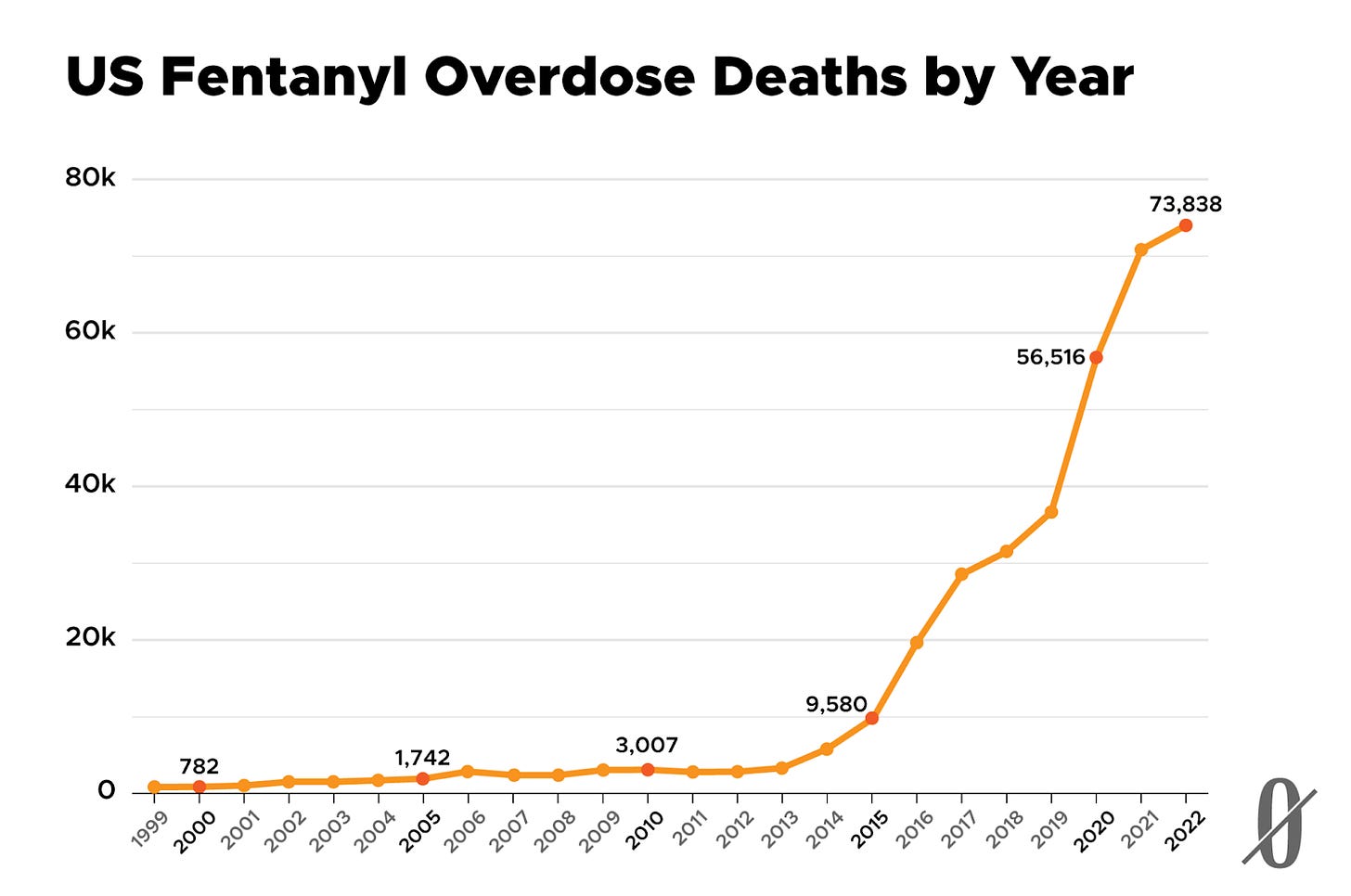America's Out-of-Control Client States
Plus: Musk's deep fake generator, China's fentanyl cooperation, China's solar dominance, Kamala foreign policy watch, why the Blob always wins, and more!
The last two weeks have brought abundant reminders that the US is better at arming and emboldening client states than controlling their behavior. News of various doings by Ukraine or Israel has come as a surprise to American officials—and, more often than not, the surprises weren’t pleasant.
On Tuesday, the State Department announced that it had approved $20 billion in new arms sales to Israel, much of which will ultimately be funded by US taxpayers. That same day, the Israeli newspaper Haaretz reported that the Israel Defense Forces (IDF) have been employing an illegal war tactic that Israel has accused Hamas of employing—using civilians as human shields. Israeli soldiers have dressed up detained Gazan civilians in IDF uniforms, bound their hands, and sent them into Hamas-controlled areas to test for booby-traps and armed militants. The tactic has been employed “all over Gaza,” and top Israeli officers are aware of it, according to Haaretz.
The State Department called the reports “disturbing,” and Haaretz reported that, behind the scenes, “the Americans are furious.”
Also Tuesday, the New York Times reported that Prime Minister Benjamin Netanyahu has quietly changed Israel’s position in ceasefire talks, adding new conditions that “his own negotiators fear have created extra obstacles to a deal.” In public, President Biden has joined Netanyahu in blaming Hamas for the lack of progress toward a ceasefire. But Biden would no doubt prefer more flexibility from Netanyahu as the US tries furiously to broker a ceasefire deal that might keep Iran from launching a widely expected assault on Israel or Israeli assets. Such an assault would be retaliation for Israel’s assassination two weeks ago of Hamas leader Ismail Haniyeh on Iranian soil—a sharp escalation in the Israel-Iran conflict that Israel reportedly didn’t clear with the US even though the US may well get drawn into any ensuing war.
This sharp escalation is not to be confused with Israel’s earlier sharp escalation—when it bombed an Iranian embassy compound in Syria, triggering an Iranian military retaliation that the US helped Israel fend off, and that nearly started a larger war. In that case, too, Israel reportedly felt no need to consult its American patron about the wisdom of escalation.
Such indifference to American opinion seems to be common in countries that are flooded with American military support. Last week, when the Ukrainian army launched its first-ever incursion into Russia, US officials told the New York Times that they were as surprised as everyone else by the move. They’d gotten no heads up, even though Biden had imposed restrictions on Ukraine’s use of US weapons inside Russia, and even though US-supplied weapons and vehicles are involved in the incursion.
Anonymous US officials speculated that the secrecy was due either to concerns over leaks or to fears that Washington “would try to persuade Ukraine to call it off.”
There are numerous reasons that the US might have preferred that Ukrainian troops stay on their side of the border. One is fear of further escalation. US officials note that Russia’s nuclear doctrine permits the use of nukes to stave off “an existential threat to the Russian state,” a threat that Putin could claim Ukrainian troops now constitute. A nuclear reaction remains very unlikely, but when you’re talking about nuclear war, a fraction of a percentage point of increased probability is worth pondering.
A more likely form of escalation is via conventional arms, as a humiliated Putin seeks to teach Ukraine a lesson. And the incursion may have made this kind of escalation not just more tempting but more practical. Though Russia now faces troop shortages, Putin may be able to squeeze a rally-‘round-the-flag effect out of Kyiv’s offensive. The sight of Ukrainian troops on Russian territory may help Moscow gain new recruits or even make a draft politically feasible.
Speaking of bold and risky Ukrainian initiatives that Ukrainian officials didn’t clear with their patrons: Germany is reportedly seeking the arrest of a Ukrainian man over his possible involvement in the 2022 bombing of the Nord Stream gas pipeline. After the attack occurred, US officials said they had no evidence that Kyiv was responsible. But according to a new report in the Wall Street Journal, Ukrainian President Volodymyr Zelensky approved the sabotage operation. Zelensky reportedly called off the plan at the urging of CIA officials, who were warned about it by Dutch intelligence. But Valerii Zaluzhny—then the commander of Ukraine’s armed forces—forged ahead anyway.
The pipeline attack (which released as much CO2 as Denmark emits in a year), would have been “sufficient reason to trigger the collective defense clause of NATO,” a senior German official told the Journal. After all, Nord Stream is partly owned by German companies and was supplying energy to western Europe. But in this case using the collective defense clause to authorize a NATO attack against an aggressor would have been awkward, since the aggressor was, as that German official put it, “a country that we support with massive weapons shipments and billions in cash” (and also a country that NATO says will eventually become part of the alliance).
Though both Ukraine and Israel qualify as “client states,” in the terminology of international relations, and both are sometimes casually referred to as US “proxies,” it’s not shocking that the US has less than complete control over them. In both cases (Israel’s especially) domestic political forces constrain the ability of US leaders to use the leverage at their disposal.
Besides, both Ukraine and Israel have their own geopolitical interests—and both Ukrainian and Israeli leaders have their own political interests—and these often won’t align with the geopolitical interests of the US or the political interests of its leaders. So it’s natural that both Ukraine and Israel would repeatedly test the limits of American control and get away with whatever they can get away with. And the Biden administration has repeatedly signaled that they can get away with a lot. (Last year’s smaller incursions on Russian soil—conducted not by the Ukrainian military but by Ukrainian paramilitaries using US weapons and with support from Ukrainian intelligence—met with no big US protest, even though some of the paramilitaries were neo-Nazis. No doubt Ukrainian officials were mindful of that precedent as they planned this year’s incursion.)
Maybe in the future, before committing vast quantities of arms to another nation, US politicians should reflect on the fact that “proxies” have agency and inevitably have interests that diverge from those of their sponsors.
Another time it might be useful to reflect on that fact is in analyzing the behavior of our adversaries. Iran hawks tend to speak about attacks undertaken by Iranian “proxies”—Hezbollah, Hamas, Houthis, Shiite militias in Iraq—as if they were ordered by Tehran. Attributing all this violence to Iran has real narrative power; it makes a US war against Iran seem that much more justified. Indeed, if Israel’s latest big escalation—the Haniyeh assassination—winds up leading to a big retaliation from Iran, expect to hear hawks in both the US and Israel advance that narrative to argue that America should join Israel in attacking Iran.
But in truth there’s no reason to think Iran has tighter control over the groups it arms than America has. And apparently that control isn’t very tight.
Donald Trump is changing with the times. Instead of just dismissing news he doesn’t like as fake news, he now dismisses some of it as deep-fake news. This week he claimed that an image of a large crowd supporting Kamala Harris was AI-generated. “This is the way the Democrats win Elections, by CHEATING,” Trump wrote on Truth Social. (All available evidence suggests the photo was real.)
This isn’t Trump’s first time presenting himself as a victim of AI manipulation. Last December, he said that the “perverts and losers” at the anti-Trump Lincoln Project had used AI in an attack ad against him.
Meanwhile, a veritable factory for deep fakes opened this week, under the management of Trump ally Elon Musk. Musk introduced a new version of Twitter’s chatbot, Grok 2, which appears to be roughly as powerful as the four existing “frontier” large language models, built by OpenAI, Anthropic, Google, and Meta. But Musk’s AI is much less filtered than the other four, and creative Twitter users immediately set about testing its limits. Thus, there are images of Musk brandishing a pro-trans-rights sign, Musk brandishing an ISIS flag, Musk brandishing an assault rifle amid the carnage from a mass shooting he just perpetrated at a school in Uvalde, Texas (we’ll spare you that link), Donald Trump and Kamala Harris in a highly unlikely pose, and, of course, a video of Trump caressing an androgynous and pregnant (and four-fingered) version of Musk.
Like Meta’s Llama, Musk’s Grok is open source, which means, among other things, that its guardrails are relatively easy to break—assuming it has any guardrails.
Who says US-China cooperation is dead? The White House announced last week that Beijing will add three fentanyl “precursor” chemicals to its list of controlled substances, a move aimed at mitigating America’s opioid overdose crisis.
In recent years, fentanyl has killed over 70,000 Americans annually. Most of the fentanyl entering the US is synthesized in Mexico using precursor ingredients manufactured in China. Experts say China’s decision to regulate the precursors will aid America’s battle against the drug, even if enforcement will be challenging given China’s behemoth chemicals industry, which includes hundreds of thousands of small factories. China will get no direct benefit, since fentanyl overdose is virtually nonexistent there.
Some US politicians who favor hawkish policies toward China say Beijing weaponizes fentanyl to “poison” Americans. But China has been cooperative on the issue when tensions are relatively low and the two countries are talking. Lili Pike, a reporter at Foreign Policy, writes that “China’s willingness, or lack thereof, to come to the United States’ aid in the fentanyl fight has for many years tracked the broader trajectory in the bilateral relationship.”
In May of 2019, China imposed severe restrictions on the production and export of fentanyl, fulfilling a promise that Chinese President Xi Jinping made to then-President Trump as the two leaders de-escalated the trade war between their nations. In 2022, Xi ceased bilateral talks on fentanyl and other issues following then-House Speaker Nancy Pelosi’s visit to Taiwan, which China considers a renegade province. Beijing restarted its cooperation when President Biden, looking to stabilize the relationship, met with Xi last November. Since then, the two superpowers have resurrected a joint counternarcotics commission, and China has, among other measures, cracked down on online platforms where precursors are sold.
This week, advocates of a more dovish US posture got another reason for optimism about the foreign policy of a Kamala Harris administration—the third such reason in the past three weeks, by our count.






